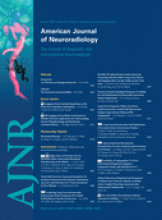Abstract
BACKGROUND AND PURPOSE: T2 relaxation times provide a continuous measure of changes in intervertebral disk biochemistry. The purpose of this study was to correlate T2 relaxation times in lumbar disks with patient age and stage of degeneration.
MATERIALS AND METHODS: Sagittal T1- and T2-weighted images and axial images were acquired in 20 patients referred for MR imaging for back pain or radiculopathy. Two readers inspected these images and assigned a Pfirrmann grade to each disk. An additional sagittal multiecho FSE image sequence was obtained, and T2 relaxation times were calculated for a each lumbar disk. T2 relaxation times were correlated with Pfirrmann grade. T2 relaxation times in nondegenerated disks were correlated with patient age. Statistical significance was tested by ANOVA, ad hoc tests, and Pearson coefficients.
RESULTS: T2 relaxation times were calculated for 95 lumbar disks in 19 patients and discarded for 5 disks in 1 patient due to motion artifacts. Forty-four disks were classified as Pfirrmann grade II; 34, as grade III; 14, as grade IV; and 3, as grade V. Mean T2 relaxation times of the central region decreased from 108 ms for grade II to 53 ms for grade IV disks. T2 relaxation times correlated significantly with Pfirrmann grade. For grade II disks, T2 relaxation times of the central region decreased significantly from an average of 132 ms for patients in their 20s to 86 ms for those in their 60s.
CONCLUSIONS: T2 relaxation times in lumbar disks correlate with stage of degeneration and patient age.
Abbreviations
- ANOVA
- analysis of variance
- FSE
- fast spin-echo
- MRI
- MR imaging
- Postop
- postoperative
- Copyright © American Society of Neuroradiology












